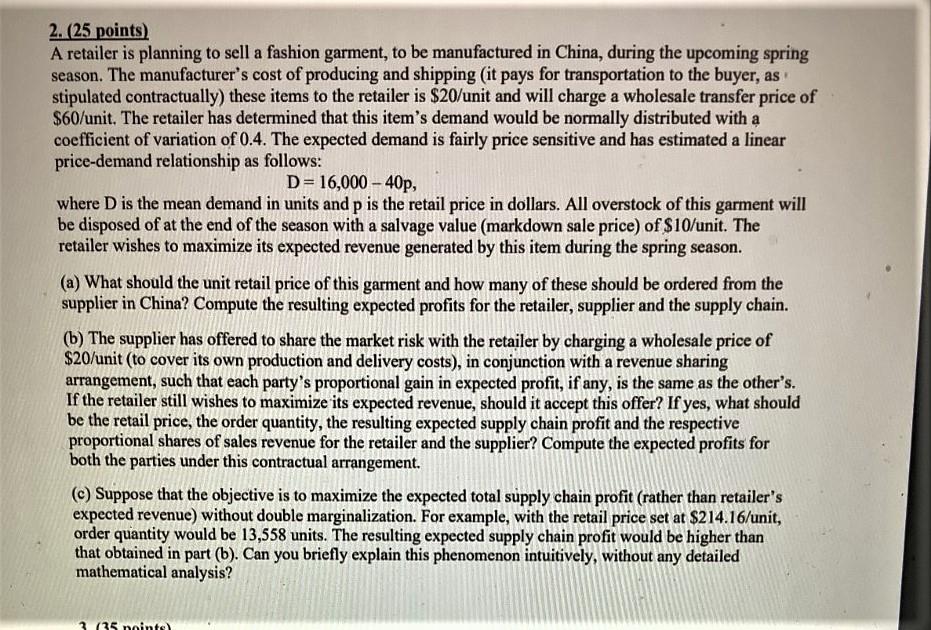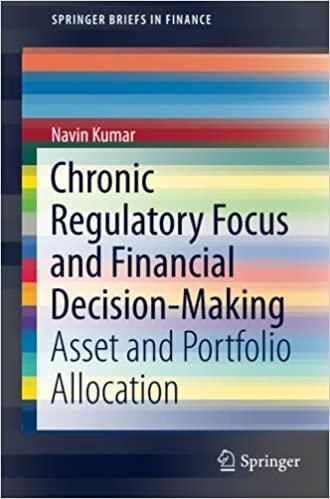Answered step by step
Verified Expert Solution
Question
1 Approved Answer
Please answer as best you can. Thank you. 2. (25 points) A retailer is planning to sell a fashion garment, to be manufactured in China,

Please answer as best you can. Thank you.
2. (25 points) A retailer is planning to sell a fashion garment, to be manufactured in China, during the upcoming spring season. The manufacturer's cost of producing and shipping (it pays for transportation to the buyer, as stipulated contractually) these items to the retailer is $20/unit and will charge a wholesale transfer price of $60/unit. The retailer has determined that this item's demand would be normally distributed with a coefficient of variation of 0.4. The expected demand is fairly price sensitive and has estimated a linear price-demand relationship as follows: D= 16,000 - 40p, where D is the mean demand in units and p is the retail price in dollars. All overstock of this garment will be disposed of at the end of the season with a salvage value (markdown sale price) of $10/unit. The retailer wishes to maximize its expected revenue generated by this item during the spring season. (a) What should the unit retail price of this garment and how many of these should be ordered from the supplier in China? Compute the resulting expected profits for the retailer, supplier and the supply chain. (b) The supplier has offered to share the market risk with the retailer by charging a wholesale price of $20/unit (to cover its own production and delivery costs), in conjunction with a revenue sharing arrangement, such that each party's proportional gain in expected profit, if any, is the same as the other's. If the retailer still wishes to maximize its expected revenue, should it accept this offer? If yes, what should be the retail price, the order quantity, the resulting expected supply chain profit and the respective proportional shares of sales revenue for the retailer and the supplier? Compute the expected profits for both the parties under this contractual arrangement. (c) Suppose that the objective is to maximize the expected total supply chain profit (rather than retailer's expected revenue) without double marginalization. For example, with the retail price set at $214.16/unit, order quantity would be 13,558 units. The resulting expected supply chain profit would be higher than that obtained in part (b). Can you briefly explain this phenomenon intuitively, without any detailed mathematical analysis? 3135 inte 2. (25 points) A retailer is planning to sell a fashion garment, to be manufactured in China, during the upcoming spring season. The manufacturer's cost of producing and shipping (it pays for transportation to the buyer, as stipulated contractually) these items to the retailer is $20/unit and will charge a wholesale transfer price of $60/unit. The retailer has determined that this item's demand would be normally distributed with a coefficient of variation of 0.4. The expected demand is fairly price sensitive and has estimated a linear price-demand relationship as follows: D= 16,000 - 40p, where D is the mean demand in units and p is the retail price in dollars. All overstock of this garment will be disposed of at the end of the season with a salvage value (markdown sale price) of $10/unit. The retailer wishes to maximize its expected revenue generated by this item during the spring season. (a) What should the unit retail price of this garment and how many of these should be ordered from the supplier in China? Compute the resulting expected profits for the retailer, supplier and the supply chain. (b) The supplier has offered to share the market risk with the retailer by charging a wholesale price of $20/unit (to cover its own production and delivery costs), in conjunction with a revenue sharing arrangement, such that each party's proportional gain in expected profit, if any, is the same as the other's. If the retailer still wishes to maximize its expected revenue, should it accept this offer? If yes, what should be the retail price, the order quantity, the resulting expected supply chain profit and the respective proportional shares of sales revenue for the retailer and the supplier? Compute the expected profits for both the parties under this contractual arrangement. (c) Suppose that the objective is to maximize the expected total supply chain profit (rather than retailer's expected revenue) without double marginalization. For example, with the retail price set at $214.16/unit, order quantity would be 13,558 units. The resulting expected supply chain profit would be higher than that obtained in part (b). Can you briefly explain this phenomenon intuitively, without any detailed mathematical analysis? 3135 inteStep by Step Solution
There are 3 Steps involved in it
Step: 1

Get Instant Access to Expert-Tailored Solutions
See step-by-step solutions with expert insights and AI powered tools for academic success
Step: 2

Step: 3

Ace Your Homework with AI
Get the answers you need in no time with our AI-driven, step-by-step assistance
Get Started


